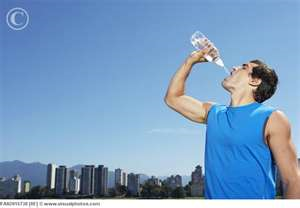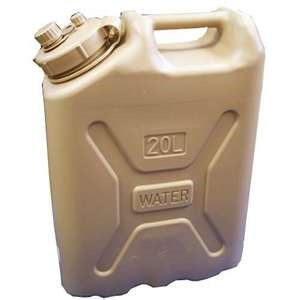What Would You Do Without Water?
By Patty Liston

There isn’t anyone who has listened to the news lately, that hasn’t had their heart turned to those who have suffered so much due to natural disasters. Tornado’s, flooding, tsunami’s, and earthquakes seem to be affecting every corner of the population.
It should not come as any surprise that after the dust has settled, so to speak, the number one commodity that survivors need, is water. Water to drink, water to wash wounds, water to cool the brows of the elderly and water to clean off crying children: where does it come from? Unless one is prepared, it comes from organizations that may take hours to get to you and your family during an emergency.
According to Carolyn Nicolaysen, a preparedness blogger (www.totallyready.com), now would be a good time for all of us to consider—or reconsider—storing water for emergencies. Every DVO reader is part of our family; and as family members, we want all of you and those you love, to be safe. This also includes our 4 legged friends!
- Do not drink sodas or alcoholic beverages in an emergency. They will greatly increase thirst.
- Do not store water containers directly on a concrete floor. The chemicals in the concrete can leach into plastic containers and contaminate your water. Place boards or two layers of carpet on the concrete first. The best bet is to store water on shelves and not on the floor at all.
- Water should be stored in containers that are filled completely to the top.
- Water should be stored in a cool, dark location.
- Water should never be stored near chemicals, pesticides, perfumed items, or products that may emit toxic gases. If you are storing water in the garage you should store it away from the car and any chemicals or in a closed cabinet.
- NEVER store water in plastic milk and juice jugs. They are too porous, difficult to sanitize, and are easily contaminated. These containers are designed to begin biodegrading as soon as they are produced and they will leak, guaranteed.
- Label all containers with the words “drinking water,” and with the date you stored it.
- If you are storing in bleach containers or other containers that are not appropriate for drinking label those Do Not Drink: for sanitation and washing only. You may know which containers contain drinkable water and which are not but would your children if they were home alone or would a visitor or someone who had evacuated to your home.
- Stored water should be rotated every year. The best advice is to choose a date you will rotate your water every year. A good time would be a special occasion that falls during the summer months — birthday, anniversary, the 4th of July. The old water can then be used to water outdoor gardens and trees.
- Train your family in the safe and responsible use of stored water. Teach them to practice conserving now and when an emergency presents itself they will not have to vary their habits as much.
- Do not use bottled water that has been exposed to flood waters. Everything that has been exposed to flood water MUST be disinfected before use. Canned goods may be used as the water will not leach through metal. Water, however and any chemicals can leach through plastic, thus the water in them should not be consumed. It may be used, after sterilizing the outside and adding bleach for flushing and cleaning.

Containers for Water Storage
- Heavy duty food grade plastic containers with a spout or a pump for dispensing water. Water is heavy and you need to consider this when choosing containers. Five gallons of water weighs 42 pounds. Containers should be manageable for one adult to lift or they should be equipped with a pump. Make sure when using plastic containers that they are approved for food use. Chemicals are available to add to storage containers preserving the water for five years, however, in most communities in the United States water is safe to store right from the tap. Check with your local water treatment facilities.
- Plastic bottles - Water may be stored in well-rinsed bleach (hypochlorite) bottles. Do not use bottles from scented bleach. Begin by cleaning bottles with hot, soapy water. Completely clean the inside and the outside of the container, including the handle, the lid. Finally, rinse with clean water. Once you clean and sanitize the container, fill it with water you know is safe and screw the cap on tightly. Since some experts say storing water in bleach containers is fine and others say it is dangerous I recommend you rotate the water at least once a year and then reserve it for cleaning and flushing toilets. These are not food grade so I would use it only for non consumption.
- Soda Bottles - Hard plastic liter soda bottles or juice bottles, with screw on lids, work well for storing drinking water. Colored bottles are the best as they filter the light. Sanitize by rinsing inside and out with a solution of one-half teaspoon of household bleach per pint of water. Finally, rinse with clean water. Once you clean and sanitize the container, fill it with water you know is safe and screw the cap on tightly. You may want to fill containers with your own tap water. Water in different areas tastes differently and your family will be accustomed to the taste of your own tap. Before using open the container for several hours. Pour water back and forth between two pitchers to add air back in and improve the taste. If the water appears cloudy treat or use it for cleaning and bathing but not for drinking. Liter bottles are also great to have on hand to grab quickly in the event you need to evacuate. They can be carried easily by an adult with the use of a lanyard type bottle carrier.
- Mylar water storage bags - These are impermeable to gases and are usually sold in bulk cardboard cases for easy stacking. Individual pouches can be purchased for storing in 72 hour kits and in your car. These pouches are not rodent proof so check them often and place small pouches in a rodent proof container. These products are dated for a 5 year shelf life but have been tested to last years longer.
- Glass jars - As you empty your canning jars sterilize them, and the lids and rings. Fill with water, place lid on bottle upside down, tighten down the ring and you have water stored until you are ready to refill bottles with the “fruits” of your gardening efforts. The gaskets on the lid can allow mold to grow so be sure the lid is place on upside down. Your canning jars are already taking up space so put them to work! Glass jars should be stored in a dark place and preferably in the original cardboard box. Water can also be canned by processing for 20 minutes in a water bath or steam canner. This is not necessary if water is rotated on a regular basis.
- Picnic coolers - Fill with water between uses.
- The bathtub - If you know a storm is approaching and there is even a remote chance you may be without water, fill your bathtubs and sinks.
- You should experiment with this before an emergency arises. If your drain does not hold the water well you will want to purchase an inexpensive stopper at the hardware store. We have left our plants in a tub with water, while on vacation for a week and the water was still there when we returned home.
- Pitchers and pots - Drag out grandma’s silver pitcher, pots, canners and anything else that can hold water. All of these items will hold water that you can safely drink. That is huge! Once items are filled cover with a lid or plastic wrap to prevent dust and ants from getting in.
- Swimming pools - Use for cleaning and bathing only.
- Hot water heaters - Make sure you turn off the power (or gas) before you attempt to drain. To get a free flow of water from the hot water tank, open the valve at the top of the tank as well as the faucet at the bottom of the tank. Increase the water flow by turning on any hot water faucet in the house before draining water from the hot water tank.
- Water beds - Use water from these for cleaning and bathing only.
- Liquids in canned fruits and vegetables are good for cooking. This is one reason I recommend you have canned foods in your General Store. Peach juice is great for cooking oatmeal. Rice and pasta cook well in the water from canned vegetables.
- Melted snow-Be sure the snow is freshly fallen and clean. Never eat snow as it will rapidly lower your body temperature.
- Rain water should be collected away from trees or structures which could contaminate the water. Mylar blankets; new, unused 5 gallon buckets; new unused garbage cans; pots and pans from the cupboard, all work well to collect water. Again remember plastic garbage cans are not food grade and the water should not be used for drinking or cooking.
- Fruit juices should be included in every emergency storage plan. They are not only useful for drinking but also adding flavors to foods such as oatmeal, and disguising the taste of medications.
- A freezer is also a good place to store water for a long period. Freeze water in plastic bottles only, glass will break. Fill containers leaving two to three inches of space at the top to prevent bursting as the water expands and freezes.
- Almost every natural disaster results in loss of potable water. Water is easy to store and it's free. Don't put it off any longer.

